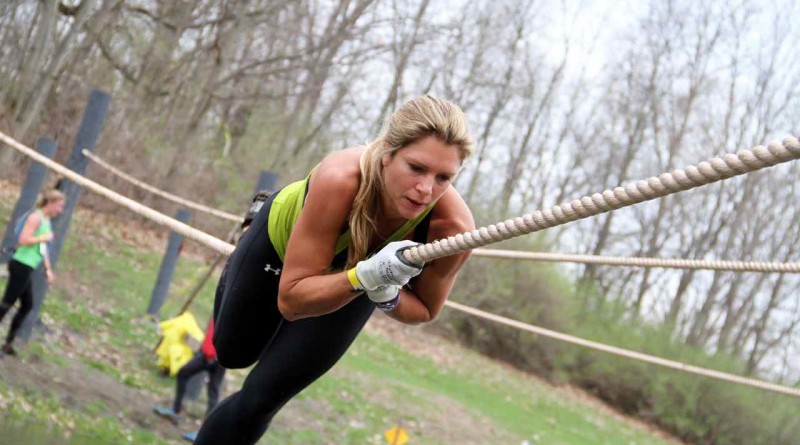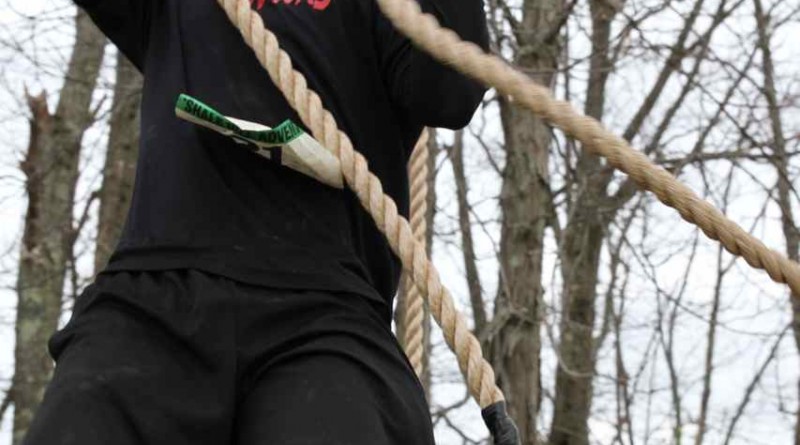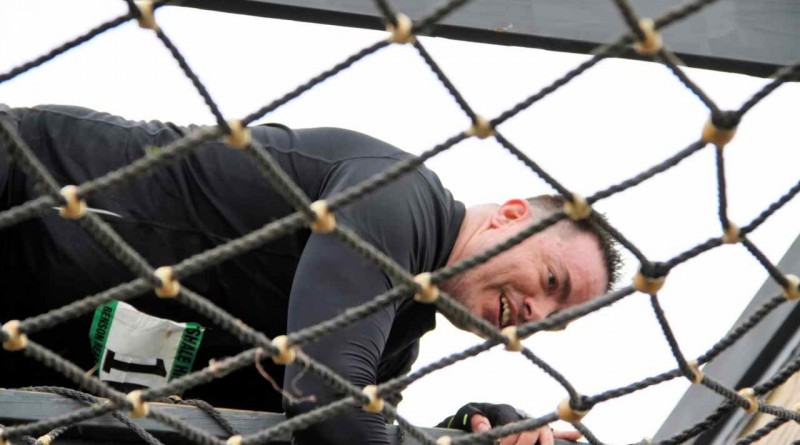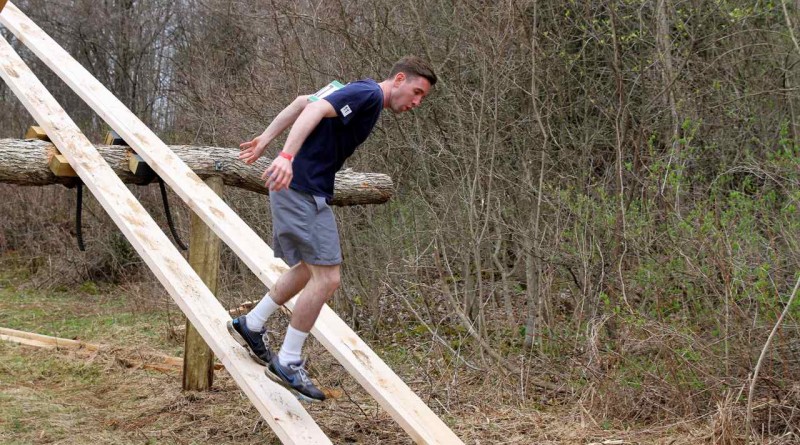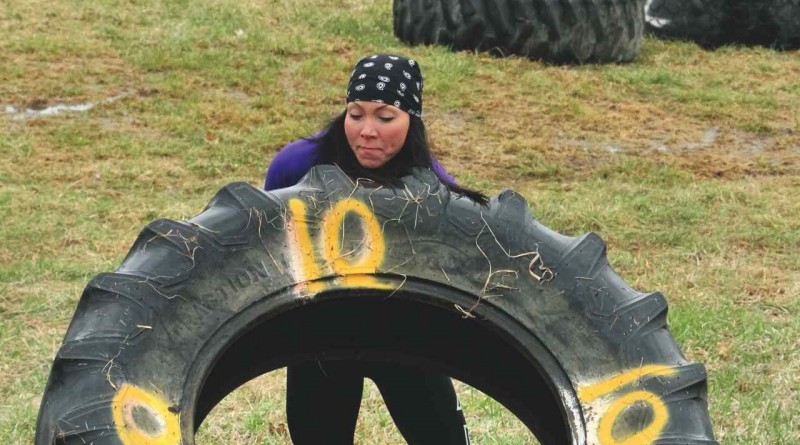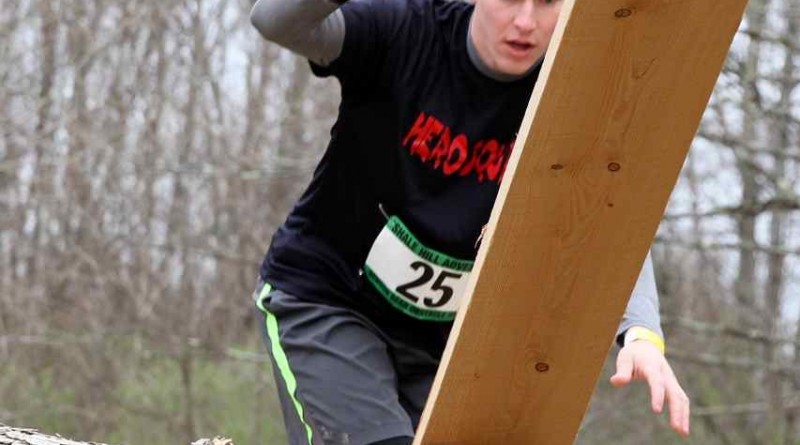Practicing pain: Athletes train to tackle Vermont’s toughest races
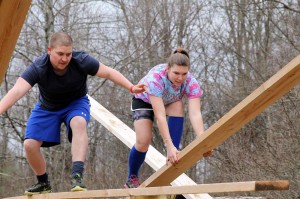
BENSON, VT. — At the Shale Hill Adventure Farm in Benson, the weather on a Saturday in early May is in the low 50s and threatening rain. Spanning a 20-yard-wide pond, a group of weary runners attempt to cross the icy water using thick ropes strung six feet above the water.
Some hang like monkeys, gripping with their hands and ankles; some drag themselves along the top of the rope and others prefer to just jump in and swim. After making it onto the muddy bank – some soggier than others — they take off toward the next obstacle along the six-mile course that is hailed as one of the toughest in the Northeast.
Shale Hill is a training center for obstacle course racing known among the initiated simply as “OCR.” The course is an important part of a fast-growing sport with hundreds of races held each year all around the world.
Michelle Forkey and John Leclerc are members of Team Burgh, an OCR team based in Plattsburgh, N.Y. and regularly train at Shale Hill. The team has experience in the world-renowned Spartan Races and Tough Mudders all over the United States in locales ranging from Miami to Las Vegas, where runners take off from the starting line in heats of as many as 200. Thousands of people routinely enter some of these races, meaning that team members have to stay in top shape for a solid finish – and that requires constant practice.
“It’s all about repetition,” says Leclerc. “When we come here, we’ll run the course and when we find something that gives us a hard time, we’ll stop and work on it.”
“As you practice, it only gets better,” adds Forkey. “Coming to work on a course as tough as this keeps us on track.”
Participation in obstacle racing has been on the rise, and as a new sport it has its own peculiarities. Rob Butler, founder and owner of Shale Hill, says the development of OCR skipped a step.
“The whole phenomenon of obstacle racing started on the second floor,” he says. “It started out as a weekend warrior type of race. People would blast through it, go home and train on their own.”
What the sport needed, he says, was a foundation, a place for athletes to start. Now, a variety of courses, classes and trainers offer expertise and resources to novices and veterans alike.
Butler says that unlike obstacle course races that vary by location, a fixed course standardizes the experience for athletes, giving them the ability to see improvement.
“At races, you can’t gauge your progress so you have no idea if you’re getting better,” he says. “Here, you know. It becomes a gauge and a good tool.”
Course work
Indoor training helps as well. Up in Essex, Vermont, John and Sheila Stawinski manage Injury to Excellence, which specializes in fitness classes geared toward obstacle course races.
A year after opening their gym in 2008, the couple competed in the inaugural Spartan Race at the Catamount Outdoor Family Center in Williston. It was 2009 and Stawinski says he recognized an opportunity.
“I thought it (the race) was really something special,” he says. “And I really wanted to get more people on board so I’d have more people to train and to race with.”
Today, Injury to Excellence operates obstacle course training classes on a local network of trails at Mount Mansfield Union High School and in an indoor gym with all the features normally found on a course, including rope climbs, cargo nets, tunnels and more. Stawinski says the indoor and outdoor exercises both have advantages.
“On the indoor course, it’s a technical environment that we’re able to control,” he says. “We’re able to develop techniques to bring outside. When you’re outside, the challenge becomes having the grit and determination to push through the mud and the natural conditions you’re presented with.”
Stawinski trains some 30 to 50 people every year in his classes for races like the World Championship Spartan Beast, which will be held in September at Killington Resort.
“Most of these people will go up and over a wall and see a figure of their self several months ago who may have been too hesitant to get over,” he says. “They can see how far they’ve come and can get right over. It gives them quite a sense of accomplishment.”
He and his wife regularly compete in the races and were joined this year by their son.
**********
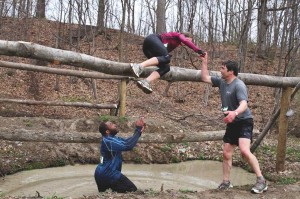
Back in Benson, Rob Butler competed in his first obstacle race in 2009. Inspired, he went home and designed and constructed a few of the first obstacle features that are now on his farm property so he’d be better prepared for his next race. Today, Shale Hill has two loops with more obstacles in half the distance of some of the longer and well-known races. The full course is 6.3 miles long and is rated among the hardest in the country by “Obstacle Race Magazine,” an accolade Butler says is warranted due to the frequency and intensity of the obstacles, not the length of the course.
“On this course, you don’t have to be the fastest runner,” he says. “You’ve got to be a universal athlete. You’ve got to be able to pull and push, tug and use every part of your body in order to succeed.”
Beyond the gym
Becoming that “universal athlete” also takes place outside of courses or gyms. Skye Nacel has been a personal trainer for 15 years and is certified through MovNat, a style of training that emphasizes the rudiments of human movement — running, jumping, climbing, throwing, carrying heavy objects like sand bags, balance and swimming, among other natural activities.
Nacel says a well-rounded athletic ability is what prepared him for races like the Spartan Beast at Killington or the Death Race at the Aimee Farm in Pittsfield. When he first heard of the races, he didn’t need to alter his training regimen.
“It wasn’t like I needed to train specifically for it,” he says. “I was already training for it. I was kind of made for it.”
The combination of cardiovascular endurance and physical power requires different kinds of skill sets, Nacel says, ones not easily built in a conventional gym setting. Nacel says people too often focus on the running aspect of the race and use whatever energy they have left to power through the challenges the obstacles present.
“I’ve seen two people running next to each other at a race, but the two people are running completely different races,” he says. “One person is really succeeding, the other may be a stronger runner, but they’re getting hammered on because they’re not doing the challenges.”
Nacel’s classes rely heavily on developing the skills for those challenges and are entirely outside and held year-round.
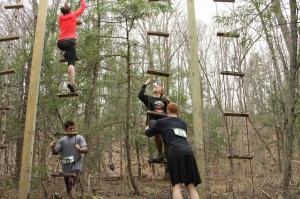 For a person accustomed to running an occasional 5k race, Jen Grant, of Lyndonville, says she was “scared as heck” when Nacel encouraged her to go for her first 13-mile Spartan Beast race. Standing 5-foot-4, Grant says her largest obstacle was summoning the mental strength to go up against some of the more intimidating obstacles, like a three-foot high wall of fire or crossing a pond suspended by a rope. Using the strategies and skills she had developed with Nacel, she was able to overcome whatever was thrown at her.
For a person accustomed to running an occasional 5k race, Jen Grant, of Lyndonville, says she was “scared as heck” when Nacel encouraged her to go for her first 13-mile Spartan Beast race. Standing 5-foot-4, Grant says her largest obstacle was summoning the mental strength to go up against some of the more intimidating obstacles, like a three-foot high wall of fire or crossing a pond suspended by a rope. Using the strategies and skills she had developed with Nacel, she was able to overcome whatever was thrown at her.
“I felt prepared,” she says. “I’m someone who always feels nervous on race day, but I felt great. A common complaint of the people that train in your standard gyms was there was no way to prepare for the hills, but I felt the exact opposite.”
Jane Coffey, of Middlesex, trained with Nacel in preparation for her first Death Race last June and has completed Killington’s Spartan races. She is currently ramping up her training in preparation for her next Death Race this summer and says she’s feeling confident with her plan, even though she hasn’t set foot inside a gym. Instead she relies on a tractor tire, a backpack full of bricks and a pile of cinderblocks. On her rest days, she goes on hikes in the White Mountains.
“You have to get used to being on your feet and training on hills,” she says. “You’re not going to be running on the flats. Burpees help too (also known as squat thrusts).”
In the world of obstacle races, participants are penalized for failure to complete a challenge (like not being able to get over a 10-foot-high wall) – usually by having to do extra push-ups or burpees. In order to avoid penalties, racers need to be comfortable and confident doing the obstacles with hands that are numb with cold or while doing obstacles in shin-deep mud.
Developing that gritty determination is what Nacel, Stawinski and Butler all emphasize. The key to OCR, they all agree, is building physical and mental toughness by completing challenges similar to those of the races regardless of weather or season.
But the benefits of such training and of obstacle course racing go far beyond just getting in great physical shape. Nacel says the races are also a good opportunity to break out of an every day routine.
“If you talk to 100 people at a race, I would venture that 70 to 90 of them work nine to five, sitting at a desk looking at a screen under artificial light,” he says, adding that OCR helps participants feel active and acutely alive. “As humans, we weren’t designed to just sit in front of a computer screen.”
Stawinski says the allure of the obstacle race is something more elemental, a reminder of a simpler time.
“The attraction is that it makes you feel like a kid again,” he says. “You’re doing things that most people haven’t done for years, and now you’re doing them and it feels really fun. You’re never bored and there’s always something around the corner waiting to challenge you.”
“And,” he adds, “It gives you a lot of great conversation for the ride home.”

